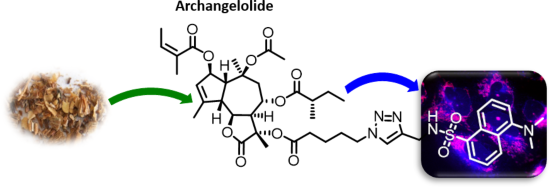Search results
Search for "azide–alkyne Huisgen cycloaddition" in Full Text gives 6 result(s) in Beilstein Journal of Organic Chemistry.
Archangelolide: A sesquiterpene lactone with immunobiological potential from Laserpitium archangelica
Beilstein J. Org. Chem. 2019, 15, 1933–1944, doi:10.3762/bjoc.15.189

- studied by us and others, there are only scarce reports on the biological activity of archangelolide. Here we present the preparation of its fluorescent derivative based on a dansyl moiety using azide–alkyne Huisgen cycloaddition having obtained the two sesquiterpene lactones from the seeds of Laserpitium
- these compounds for further work including synthetic modifications using azide–alkyne Huisgen cycloaddition. We previously showed the preparation of fluorescent trilobolide conjugates [8] that retained the activity of the parental compounds and proved to be useful for live-cell imaging. In this article
Recent applications of click chemistry for the functionalization of gold nanoparticles and their conversion to glyco-gold nanoparticles
Beilstein J. Org. Chem. 2018, 14, 11–24, doi:10.3762/bjoc.14.2
- glycoscience. In this review we present recent advances made in the use of one type of click chemistry, namely the azide–alkyne Huisgen cycloaddition, for the functionalization of gold nanoparticles and their conversion to glyco-gold nanoparticles. Keywords: azide–alkyne Huisgen cycloaddition; carbohydrates
- azide–alkyne Huisgen cycloaddition AuNP surface modification using NCAAC The azide–alkyne Huisgen cycloaddition (AAC) is a 1,3-dipolar cycloaddition between an organic azide and an alkyne that gives triazole products [37][38]. The non-catalysed azide–alkyne Huisgen cycloaddition (NCAAC) is very slow
- ]. The versatility of the Cu(I)-catalysed azide–alkyne Huisgen cycloaddition (CuAAC) has been demonstrated by its robustness, insensitivity to water and oxygen, and its applicability to a wide range of substrates [42][43][44]. Although the AAC has been used by many groups to modify the surface of AuNPs
A versatile route to polythiophenes with functional pendant groups using alkyne chemistry
Beilstein J. Org. Chem. 2016, 12, 2682–2688, doi:10.3762/bjoc.12.265
- of such functionalization using a Sonogashira cross-coupling [26] and an azide–alkyne Huisgen cycloaddition [27]. One of the advantages of the cross-coupling and click chemistry is that it allows for reaction conditions tolerant for nearly all of the above mentioned functional groups. Additionally
Azobenzene dye-coupled quadruply hydrogen-bonding modules as colorimetric indicators for supramolecular interactions
Beilstein J. Org. Chem. 2012, 8, 486–495, doi:10.3762/bjoc.8.55
- % yield. Alternatively, azobenzene dye 16 underwent a room-temperature copper-catalyzed azide–alkyne Huisgen cycloaddition with DeUG alkyne 17 to give triazole 18 in 71% yield. Azobenzene coupled DAN modules 5, 8, and 10 are bright orange–red in color, and azobenzene coupled DeUG modules 12 and 18 are
- EDC and DMAP in methylene chloride, and the orange–yellow product 12 was isolated in a relatively low 35% yield (Scheme 3). No attempt was made to optimize the coupling conditions; instead, attention was turned to the possibility of coupling the partners by using the copper-catalyzed azide–alkyne
- Huisgen cycloaddition (click reaction). The click approach began with the readily available and inexpensive starting material, 4-aminobenzoic acid (Scheme 4), which was diazotized and treated with phenol to afford 13 in 65% yield, comparable to published procedures [52][53][54]. To install the azide
Synthesis of 2-amino-3-arylpropan-1-ols and 1-(2,3-diaminopropyl)-1,2,3-triazoles and evaluation of their antimalarial activity
Beilstein J. Org. Chem. 2011, 7, 1745–1752, doi:10.3762/bjoc.7.205
- 1,2,3-triazole moiety instead. A powerful methodology towards the synthesis of functionalized 1,2,3-triazoles involves the Cu(I)-catalyzed azide-alkyne Huisgen cycloaddition (CuAAC) [33], which has gained major interest from the synthetic community due to its high efficiency and selectivity. Eligible
Advances in synthetic approach to and antifungal activity of triazoles
Beilstein J. Org. Chem. 2011, 7, 668–677, doi:10.3762/bjoc.7.79
- nitrogen atoms. However, flash vacuum pyrolysis at 500 °C leads to loss of molecular nitrogen (N2) to produce aziridine. Certain triazoles are relatively easy to cleave by ring–chain tautomerism. Synthesis of triazoles Substituted 1,2,3-triazoles can be produced by the azide–alkyne Huisgen cycloaddition in









































































